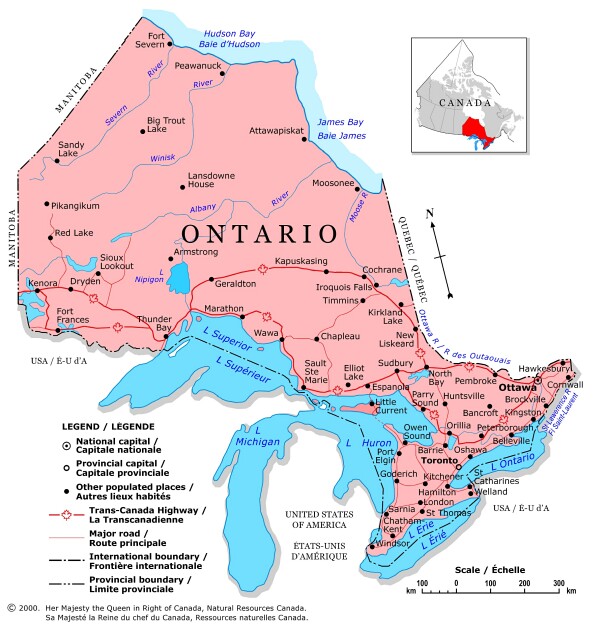
 |

|
Ontario
The Land
The name "Ontario" comes from the Iroquois word "Kanadario"
meaning "sparkling water." The name is fitting: not only is Ontario
bordered on the south by the Great Lakes and on the north by Hudson Bay, but 177
390 km2, or one sixth of its terrain, is covered by rivers and lakes.
Three main geological regions make up Ontario: the Great Lakes-St. Lawrence Lowlands, the Canadian Shield and the Hudson Bay Lowlands. The latter are narrow coastal plains bordering Hudson Bay and James Bay; the land is wet and covered by scrub growth. The Canadian Shield, covering the rest of northern Ontario from Lake Superior to Hudson Bay and extending into the southern part of the province, is a vast rocky plateau. Although the soil is poor and not well suited to large-scale farming, there is a wealth of minerals, forests and water power.
The Canadian Shield and the Hudson Bay Lowlands cover 90 percent of the province's 1 068 580 km2 of territory, but are home to only 10 percent of the population. Northern Ontario's towns were built because of the railway, and today rails and roads carry the products of the mines and mills southward. Farther north, travel is often limited to air and water. The extremes of the northern climate are a fact of life there. At Winisk, mean daily temperatures reach only 12 to 15oC in July, dropping to -25oC in January.
The five Great Lakes are the most visible results of the ice age in Ontario, and the biggest, Lake Superior, is the world's largest body of fresh water.
The Great Lakes-St. Lawrence Lowlands make up the rest of southern Ontario and contain most of the population, industry, commerce and agricultural lands. The Lowlands include the Windsor-Thousand Islands-St. Lawrence Valley triangle. Mean annual summer temperatures reach 22oC in the south, where the temperate climate and fertile soils nurture a major agricultural industry. This relatively small area has more than half of Canada's best agricultural land.
Toronto, Ontario's capital and Canada's largest city, with a regional population of more than four million, is Canada's leading producer of manufactured goods and headquarters of a large number of Canadian companies. Ottawa, the bilingual, bicultural national capital, sits at the junction of the Gatineau, Rideau and Ottawa rivers.

![]()